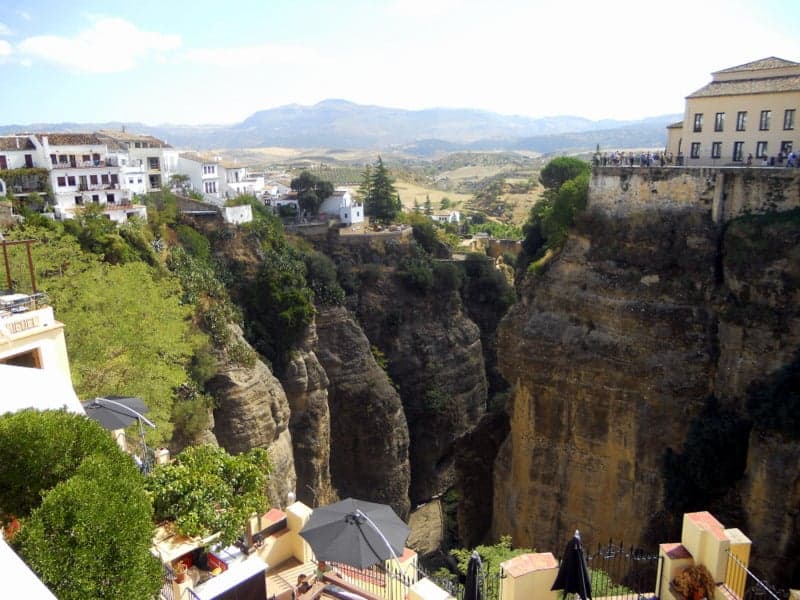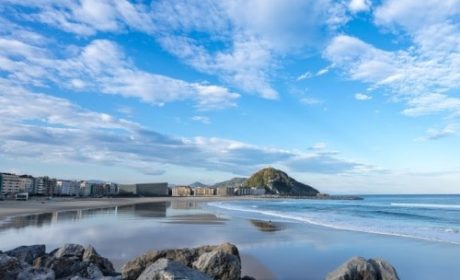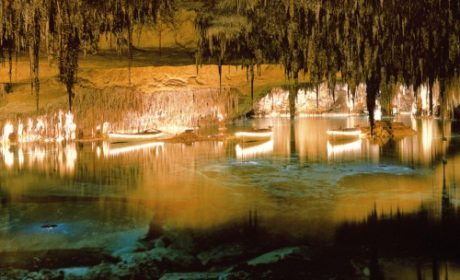Beautiful Seville is without a doubt the crown jewel in Spain’s Andalusia region. In fact, we think it’s one of the best destinations in Spain.
Although fairly easy to explore by simply walking around the picturesque city, today’s guest contributor, Naomi Elster, is here to tell us how to spend an active weekend in Seville. Be sure to follow her tips when planning your itinerary.
The green Guadalquivir, which runs through Seville, looks calm, peaceful, and flat. That is, until you’re actually in it.
The evening before last year’s supersprint triathlon in Seville, I picked up my rental bike from a small, cobbled square in the old town and coasted to the island of La Cartuja along a flat, easy cycle lane. A few small waves, I thought, glancing down as I crossed one of Seville’s many bridges, nothing major.

That perspective shifted the next day; after all, a wave need only be a few inches for it to be over head height. Seville will always be one of my favorite places to spend an active weekend – even if no other weekend there has been quite as ‘active’ as that one.
Table of Contents
Plaza de España

I encountered a ‘Spanish Square,’ usually the most extravagant feature in every Spanish city, town or village I visited. Seville’s Plaza de España has got to be one of the most spectacular in the country.
For a year, starting in May 1929, Seville hosted a world fair to improve its relationships with countries it was politically aligned with, and its former colonies.
The magnificent Plaza de España was created over two decades to host this Ibero-American Exposition. Imposing towers, built in a style that is part art deco, part meant to resemble the region’s Moorish history, curl around in a semi-circle behind a green moat, accessible by ornate bridges. Much of the lower wall is made up of colorful tiled alcoves, representing the different cities and provinces in Spain.
The palaces, sadly less grandly impressive on the inside, are now used as government offices. Among the tourists taking selfies, Spaniards pose for portraits in front of the alcove of their hometown. Foreign residents queue up along one of the semi-covered pavilion walkways, waiting to get in to the office where they can get their essential NIE residence cards.

The Plaza de España is at the end of Seville’s main park, the Parque de María Luisa. The expansive, carefully designed green space of trees, fountains, and boulevards was once intended to occupy the entire southern wedge of the city.
The park is perfect for a walk as brisk or gentle as your mood allows. If you fancy a slightly brisker pace with less effort, horse-drawn carriages are available to give you a tour.
Boomer Travel Tip
MedjetAssist Members who are hospitalized 150 miles from home receive medical transport to a home-country hospital of choice. Memberships from $99.
Captivating Sights in the Central District
Tore del Oro

Though not built, as the name suggests, of gold, the pale bricks of the dramatic, 12-sided Torre del Oro glint in the sun and cast a golden reflection in the Guadalquivir, hence its name. Rivers were often essential to a city’s survival, and Seville is no exception.
A breach of the river’s defenses was one of the things that eventually brought an end to the reign of the Almohada Dynasty. They this watchtower to control river access to the city, and keep an eye on the docks.
It was subsequently used by kings as a store for their gold, silver, and occasionally, mistresses. You can climb to the top (if you’re feeling brave), take a river cruise from any of the boats that leave from in front of it (with many vendors touting for customers around the tower, purchasing bus and boat tickets won’t be difficult).
Should you choose to stay in one of Seville’s less central districts such as Macarena, where fantastic deals can sometimes be had on luxury hotels, the Torre del Oro is a great landmark to tell you where to get off the bus for the center.
Seville Cathedral and La Giralda
There’s a local rumor that in the 1400’s, city authorities joked that they should “build a church so large future generations will think we’re mad.” The result was Seville’s Cathedral.

It is the largest gothic cathedral in the world and dominates the city center, with tram lines, tapas bars, Starbucks and a huge FNAC swanky department store running down one side of it. The other side of the cathedral feels decidedly less modern, with horse-drawn carriages, again, queuing up underneath La Giralda, the spectacular bell tower and one of Seville’s best known calling cards.
Barrio de Santa Cruz
Right next to the Giralda, the neighborhood of Santa Cruz is exquisitely beautiful. The streets were created to be narrow to protect the inhabitants from the fierce heat of summer.
Be warned that the whitewashed streets full of fine art shops are delightfully disorientating. One friend who has lived in Seville all her life jokes that she can get in to the Barrio de Santa Cruz by design any time she likes, chance determines when she finds her way out of it.
Boomer Travel Tip
In today’s travel climate, trip insurance is a must. Compare policies and rates at InsureMyTrip.
Flamenco and Seville
One of the most famous, quintessential Seville events is its annual Fería de Abril in which people dress up in traditional costume, the type usually only worn by performing flamenco dancers. Plan ahead as prices skyrocket this week, transport becomes so overcrowded passengers are turned away, and unless you have local connections, you won’t be allowed in to most of the festival tents.
Fiery, full-blooded flamenco is common here, where children usually start learning the local, related Sevillanas folk dance at academias de baile at the age of four.
Calle Cuna is an interesting street within the more mainstream shopping district for anyone with even a passing interest in learning about dancing flamenco in Seville. You’ll find many specialist shops displaying the heavily decorated, frilled dresses and weighted shoes that are as much a percussion instrument as footwear.

If you fancy leaving the sun for a little while, the pretty Plaza del Museo contains a Museum of Fine Art, and there’s a small but excellent science museum and planetarium next to Parque María Luisa.

Seville’s story was written by the Guadalquivir, so unsurprisingly, there’s a pleasant riverside walk and many beautiful bridges, of which Puente de Isabel II is the oldest and best known.

Finally, when you’ve clocked up most of the other landmarks, head to the locally controversial Las Setas modern art installation which rises and spreads over the city like the mushroom for which it is named. A small admission fee includes a free postcard from the gift shop and a most welcome cold drink (residents of Seville get free admission). The views over the city from the raised walkway, accessible by lift, are magnificent.
Where to eat in Seville

Santa Cruz is awash with bars and restaurants which are generally regarded as over-priced tourist traps by residents. Instead, go to the Alameda de Hercules street for a vibrant selection of eateries and bars.
Be sure to head to the local institution Taberna Coloniales, which attrats locals from all over the province to one of its two restaurants in the center. Go for lunch if you don’t want to join the queue which routinely stretches down the street.



